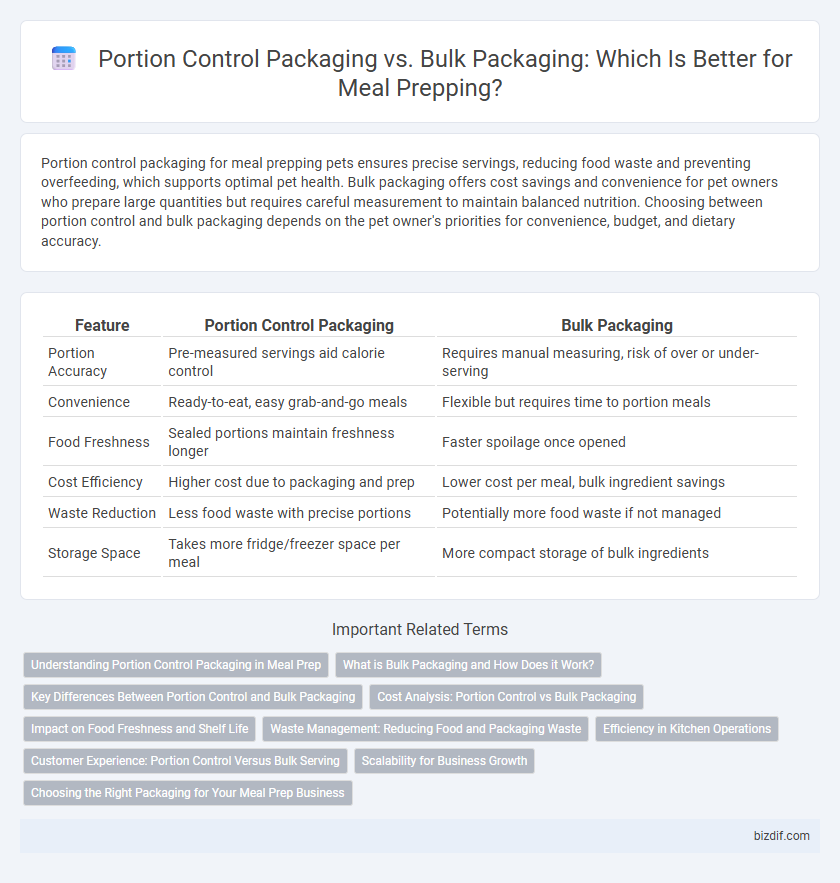Portion control packaging for meal prepping pets ensures precise servings, reducing food waste and preventing overfeeding, which supports optimal pet health. Bulk packaging offers cost savings and convenience for pet owners who prepare large quantities but requires careful measurement to maintain balanced nutrition. Choosing between portion control and bulk packaging depends on the pet owner's priorities for convenience, budget, and dietary accuracy.
Table of Comparison
| Feature | Portion Control Packaging | Bulk Packaging |
|---|---|---|
| Portion Accuracy | Pre-measured servings aid calorie control | Requires manual measuring, risk of over or under-serving |
| Convenience | Ready-to-eat, easy grab-and-go meals | Flexible but requires time to portion meals |
| Food Freshness | Sealed portions maintain freshness longer | Faster spoilage once opened |
| Cost Efficiency | Higher cost due to packaging and prep | Lower cost per meal, bulk ingredient savings |
| Waste Reduction | Less food waste with precise portions | Potentially more food waste if not managed |
| Storage Space | Takes more fridge/freezer space per meal | More compact storage of bulk ingredients |
Understanding Portion Control Packaging in Meal Prep
Portion control packaging in meal prepping enhances dietary accuracy by offering pre-measured servings that reduce overeating and support nutritional goals. This packaging type helps maintain freshness and prevents food waste through airtight, compartmentalized containers designed for individual meals. Portion control packaging is ideal for athletes, dieters, or busy individuals seeking convenience and consistency in calorie and nutrient intake.
What is Bulk Packaging and How Does it Work?
Bulk packaging involves storing large quantities of food together without individual portion separation, which helps reduce packaging waste and lowers overall costs. It works by allowing users to measure and distribute food portions manually according to their specific dietary needs, offering flexibility but requiring more effort during meal prep. This method is ideal for families or individuals who prefer customizing portion sizes and managing calorie intake directly during meal assembly.
Key Differences Between Portion Control and Bulk Packaging
Portion control packaging divides meals into pre-measured servings, ensuring consistent calorie and nutrient intake while reducing food waste. Bulk packaging stores large quantities of food, offering cost-effectiveness and flexibility but requiring additional effort to portion meals accurately. Choosing between these methods depends on convenience, dietary goals, and storage preferences.
Cost Analysis: Portion Control vs Bulk Packaging
Portion control packaging often incurs higher upfront costs due to individual packaging materials and labor but reduces food waste by providing precise servings, ultimately leading to cost savings over time. Bulk packaging offers lower initial expenses per unit but may result in increased spoilage and portion inconsistency, which can drive up overall meal costs. Analyzing cost-effectiveness requires balancing packaging expenses against waste reduction and convenience factors in meal prepping.
Impact on Food Freshness and Shelf Life
Portion control packaging enhances food freshness by minimizing exposure to air and contaminants, which slows oxidation and microbial growth, thereby extending shelf life. In contrast, bulk packaging increases the risk of repeated exposure to environmental factors each time the container is opened, accelerating spoilage. Studies show that sealed, individual compartments in portion control packs better preserve nutrient integrity and moisture levels compared to bulk storage methods.
Waste Management: Reducing Food and Packaging Waste
Portion control packaging minimizes food waste by providing pre-measured servings tailored to individual needs, reducing the risk of overeating and spoilage. Bulk packaging often leads to excess food exposure, increasing the likelihood of waste due to improper storage or portion overestimation. Efficient waste management favors portion-controlled containers made from recyclable or biodegradable materials to curb both food and packaging waste effectively.
Efficiency in Kitchen Operations
Portion control packaging streamlines kitchen operations by reducing waste and simplifying inventory management, ensuring consistent meal sizes and faster serving times. Bulk packaging allows for flexible ingredient use but requires additional labor for measuring and dividing portions, which can slow down preparation processes. Efficient kitchens often balance both methods, using portion control for high-volume items and bulk packaging for customizable dishes.
Customer Experience: Portion Control Versus Bulk Serving
Portion control packaging offers precise meal sizes that enhance convenience and reduce food waste, improving the overall customer experience by simplifying calorie management and meal planning. Bulk packaging provides flexibility for individuals who prefer customizing their portions but may lead to inconsistent serving sizes and potential overconsumption. Customers choosing portion control often appreciate the time savings and ease of use, while bulk packaging appeals to those seeking cost savings and personalized meal quantities.
Scalability for Business Growth
Portion control packaging offers precise serving sizes that streamline inventory management and minimize food waste, making it ideal for scalable meal prep businesses aiming to maintain consistency and meet diverse customer needs. Bulk packaging reduces packaging costs and simplifies supply chain logistics, but may require additional labor for portioning, potentially slowing down scaling efforts. Efficient scalability in meal prepping hinges on balancing the cost-effectiveness of bulk packaging with the customer satisfaction and operational control benefits of portion control packaging.
Choosing the Right Packaging for Your Meal Prep Business
Portion control packaging enhances meal prep accuracy by ensuring consistent serving sizes, reducing food waste, and improving customer satisfaction. Bulk packaging lowers packaging costs and is ideal for clients who prefer flexibility in meal portions, but it may lead to less precise calorie tracking. Selecting the right packaging depends on your target market's needs, balancing cost-efficiency with convenience and portion accuracy.
Portion Control Packaging vs Bulk Packaging Infographic

 bizdif.com
bizdif.com